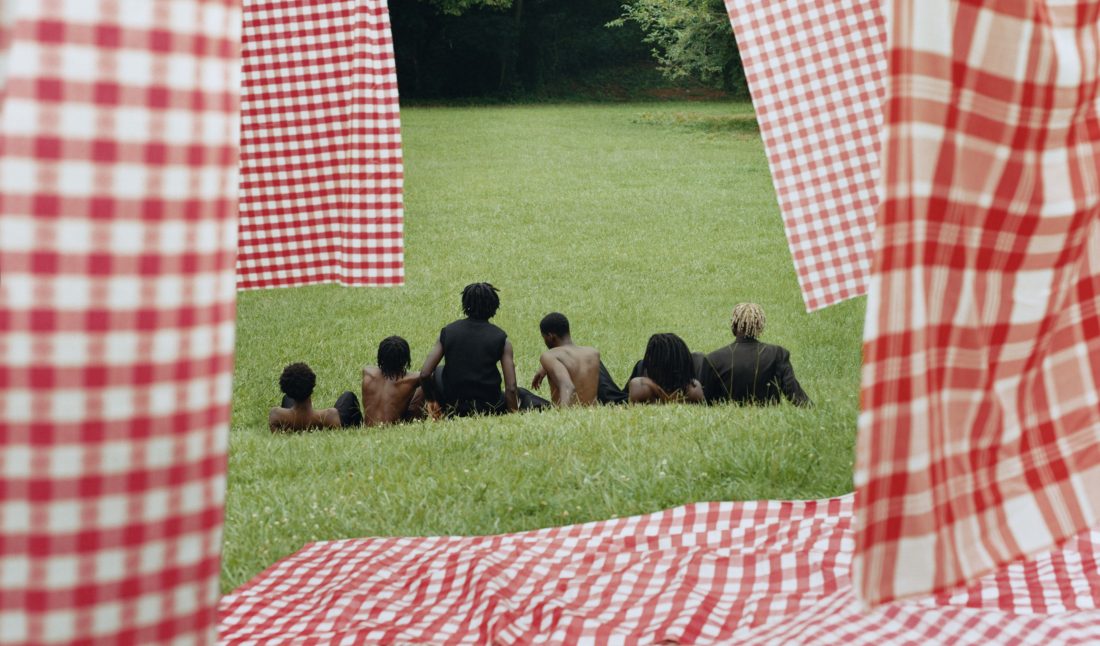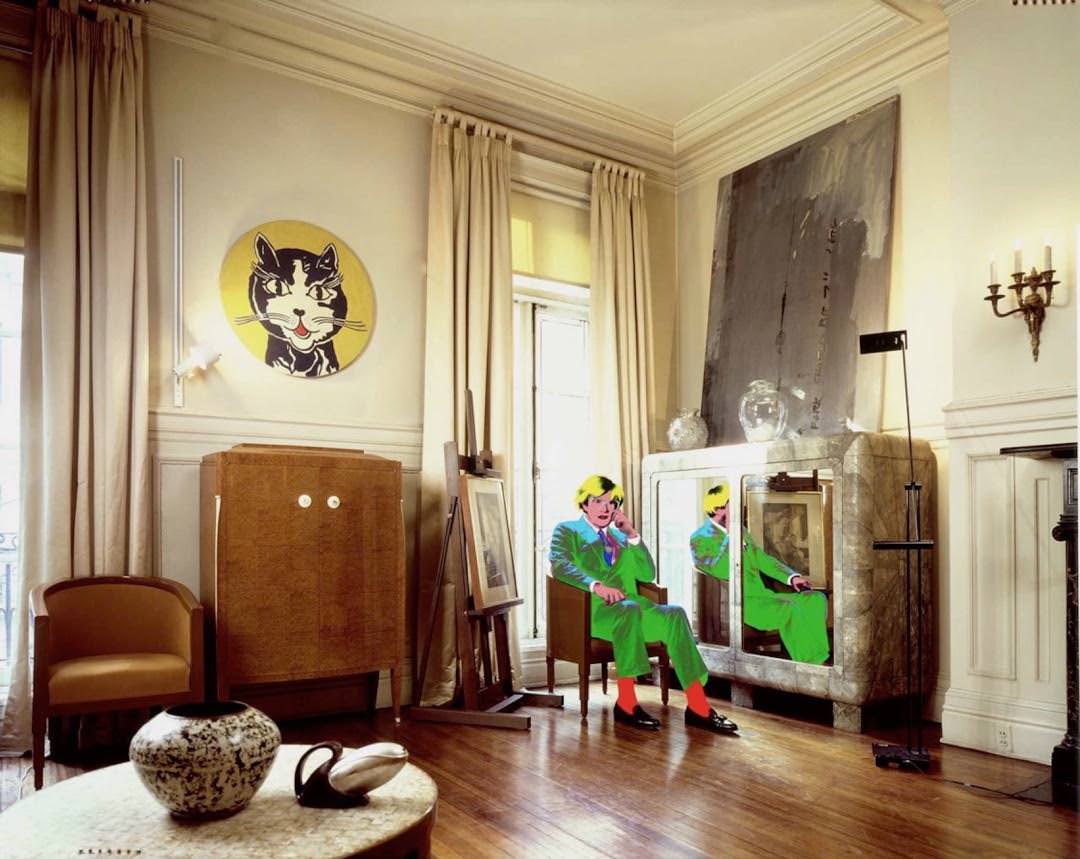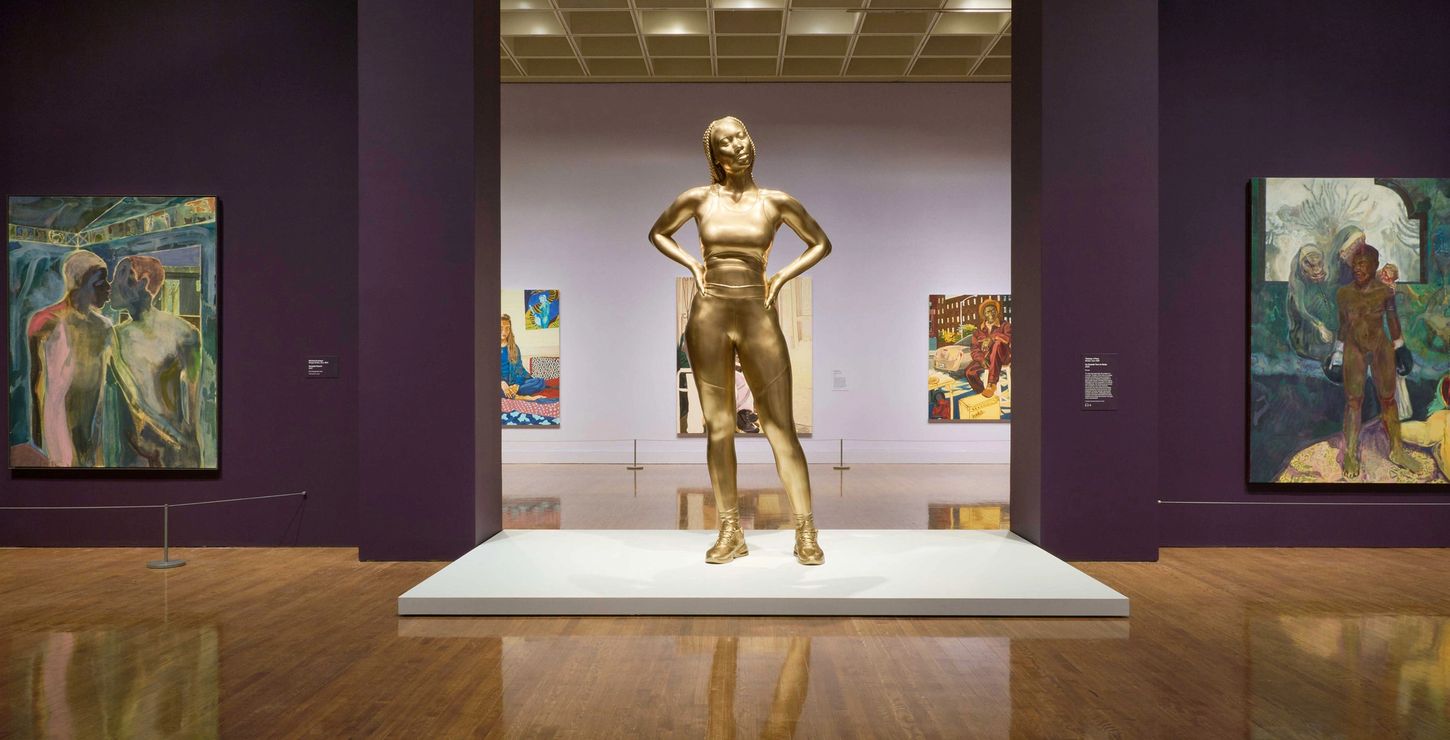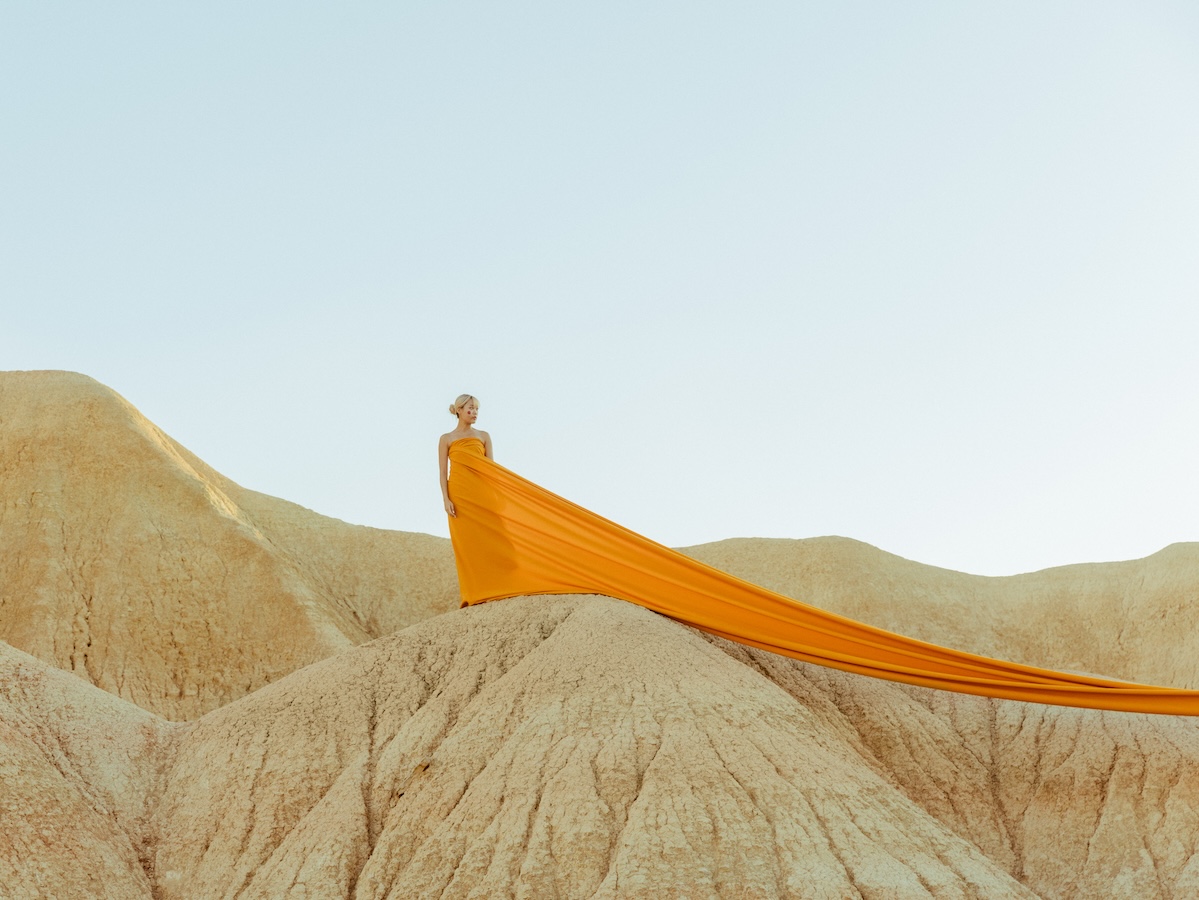Tyler Mitchell has been on a hot streak since 2018, one year after graduating from the film department at New York University. It was then at just 23 years old that he photographed Beyoncé for the cover of American Vogue, marking the first time an African American photographer had captured the magazine’s cover.
In 2019, the Smithsonian National Portrait Gallery acquired one of his portraits of Beyoncé, and his first solo exhibition, “I Can Make You Feel Good,” opened at Foam museum in Amsterdam. The show revealed personal and commissioned images alongside two of his films, Idyllic Space and Chasing Pink, Found Red. In January 2020, a second iteration appeared in New York City at the International Center of Photography, with a selection of images printed on fabrics and hung on a laundry line down a 60-foot hallway. With the physical environment playfully activated, Mitchell’s images were presented conceptually as art, evolving the idea of what his practice was and could be.
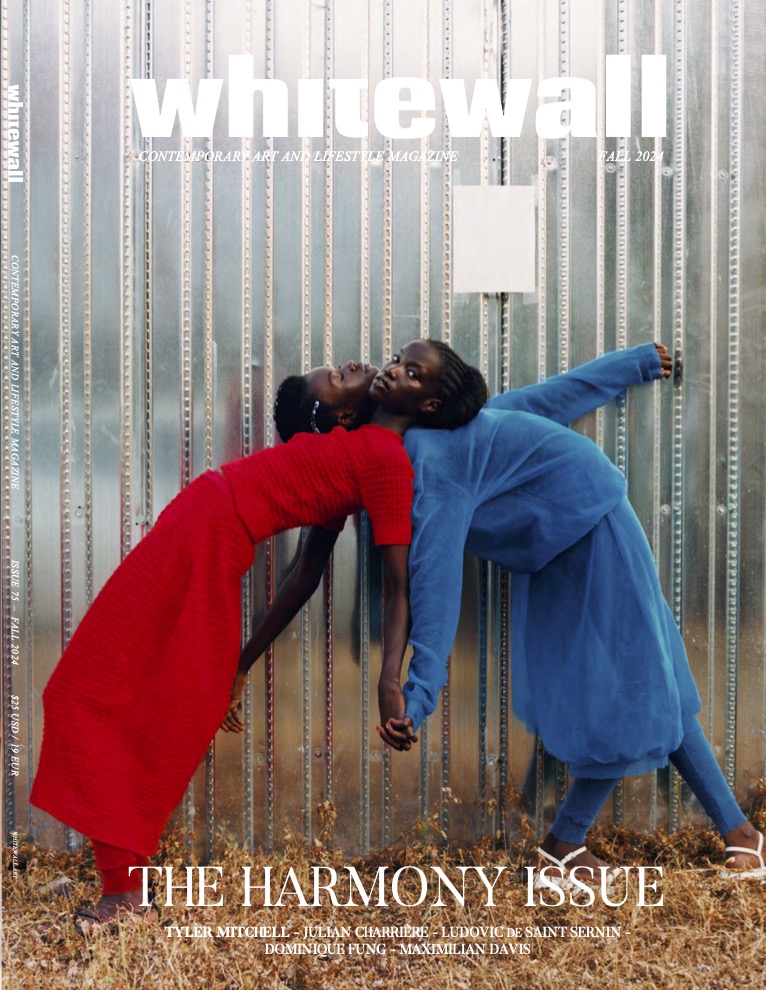 Whitewall’s Fall 2024 cover featuring “Untitled (Trust),” 2018 by Tyler Mitchell.
Whitewall’s Fall 2024 cover featuring “Untitled (Trust),” 2018 by Tyler Mitchell.
His work has since appeared in esteemed galleries, institutions, and universities, like Jack Shainman Gallery, the Savannah College of Art and Design (SCAD), and the Victoria & Albert Museum. Fashion brands, tech giants, and magazines—like Louis Vuitton, LOEWE, Moncler, Apple, Vanity Fair, W, and The Wall Street Journal—have also flocked to get in front of Mitchell’s lens, looking to tap into his spark, something felt and not just seen. A kaleidoscopic tapestry of self-expression and freedom, Mitchell’s images are celebrated for blending culture with societal complexities important to both the subject and the viewer. From race and age to joy and stillness, underlying messages are revealed through traces of emotion and a visual symphony of light, color, texture, and time.
Meanwhile, Mitchell remains true to his personal life and experiences as a Black American photographer from the South. These meditations are explored in depth in his exhibitions opening this summer: “Wish This Was Real” at C/O Berlin in Germany (June 1–September 5) and “Idyllic Space” (June 21–December 1) at the High Museum in Atlanta, Georgia. The latter is a major homecoming for the artist, as he was born and raised in Atlanta, and it was the first museum he visited as a child. Here, Mitchell reveals a collection of photographs, films, sculptures, and even the work of artists that have influenced him over the past decade, aiming to connect the ideas of the human condition and home to the United States and abroad.
The luminary artist shared with Whitewall how he confronts the zeitgeist with an eye on culture, youth, and his own experiences for an honest look at life today.
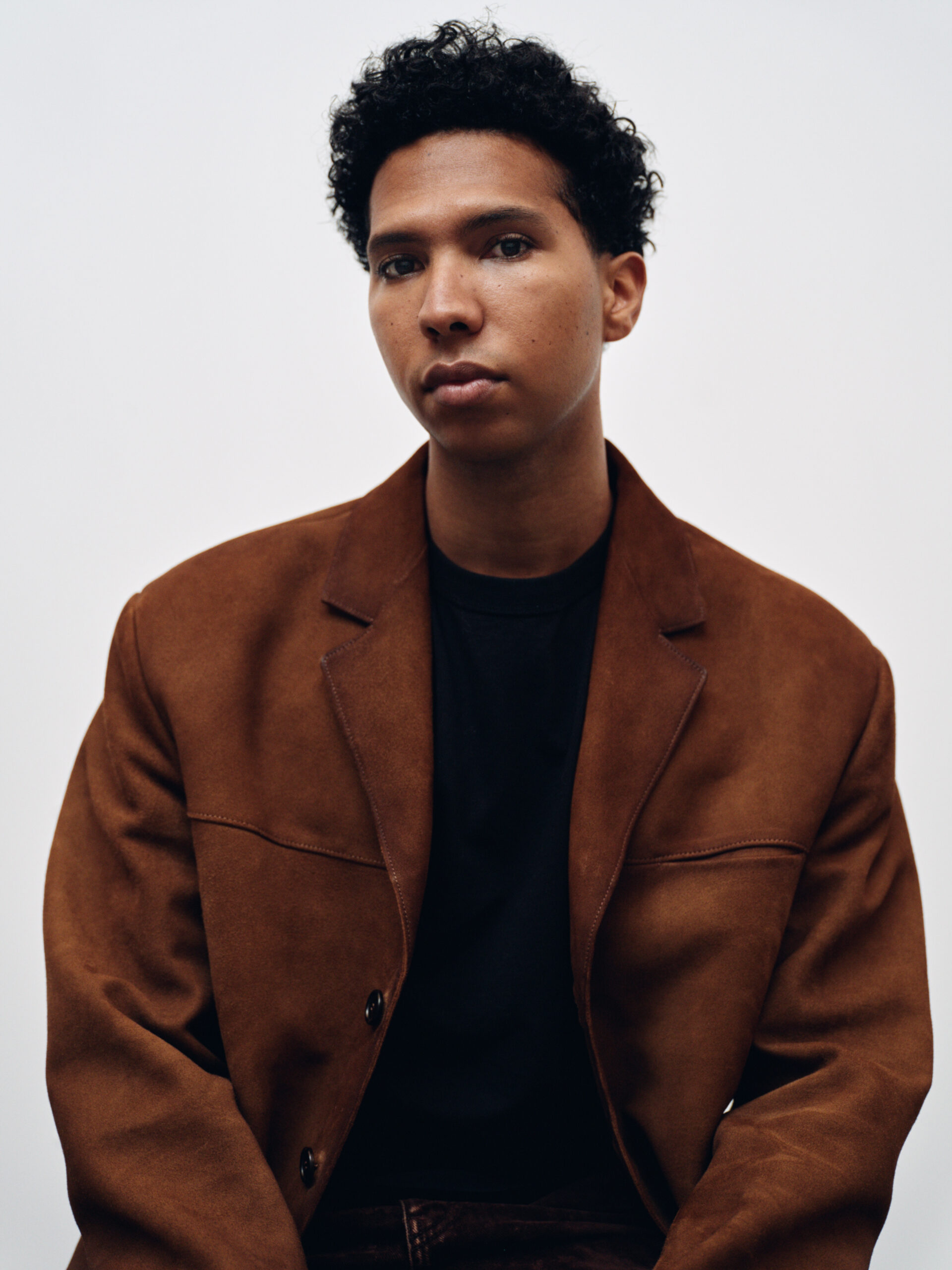 Self-portrait courtesy of Tyler Mitchell.
Self-portrait courtesy of Tyler Mitchell.
WHITEWALL: We last spoke during the coronavirus pandemic in 2020, just after your first solo exhibition. You’re now presenting two shows this summer alone. How has your idea of showing photography in this way evolved?
TYLER MITCHELL: Exhibition-making is still very new to me. Foam museum in Amsterdam was great at holding my hand and shepherding me into feeling confident to exhibit my work.
My family is not a family of artists. I didn’t previously have a formal education in understanding photographs as art objects. So this has been a long process of growth, and I’m happy to have reached this place. My confidence with each exhibition has expanded, and this feels like the most ambitious effort of introducing all the ideas going on in my practice. It brings together nearly ten years of work, and introduces some new work and, of course, older works going back to 2016. That’s the idea. Not every show always needs to be something new. Sometimes reintroducing and doubling down and exhausting one’s conceptual conceits and ideas going on in my work could excite an audience and be instrumental or useful or helpful to a community at this time.
I mention my show in Amsterdam because I hope the show in Berlin will be just as exciting. I look forward to engaging with and seeing what the young people of Germany have to say about my work. How people there react or don’t react. I’m also welcoming the idea that as someone making work from a Black American perspective, some might not get it—or like it or fully understand all the levels that I’ll bring to it. I’m fascinated to see what the energy in my work will do in that space and context. The idea that Blackness is a global project is a really exciting gesture.
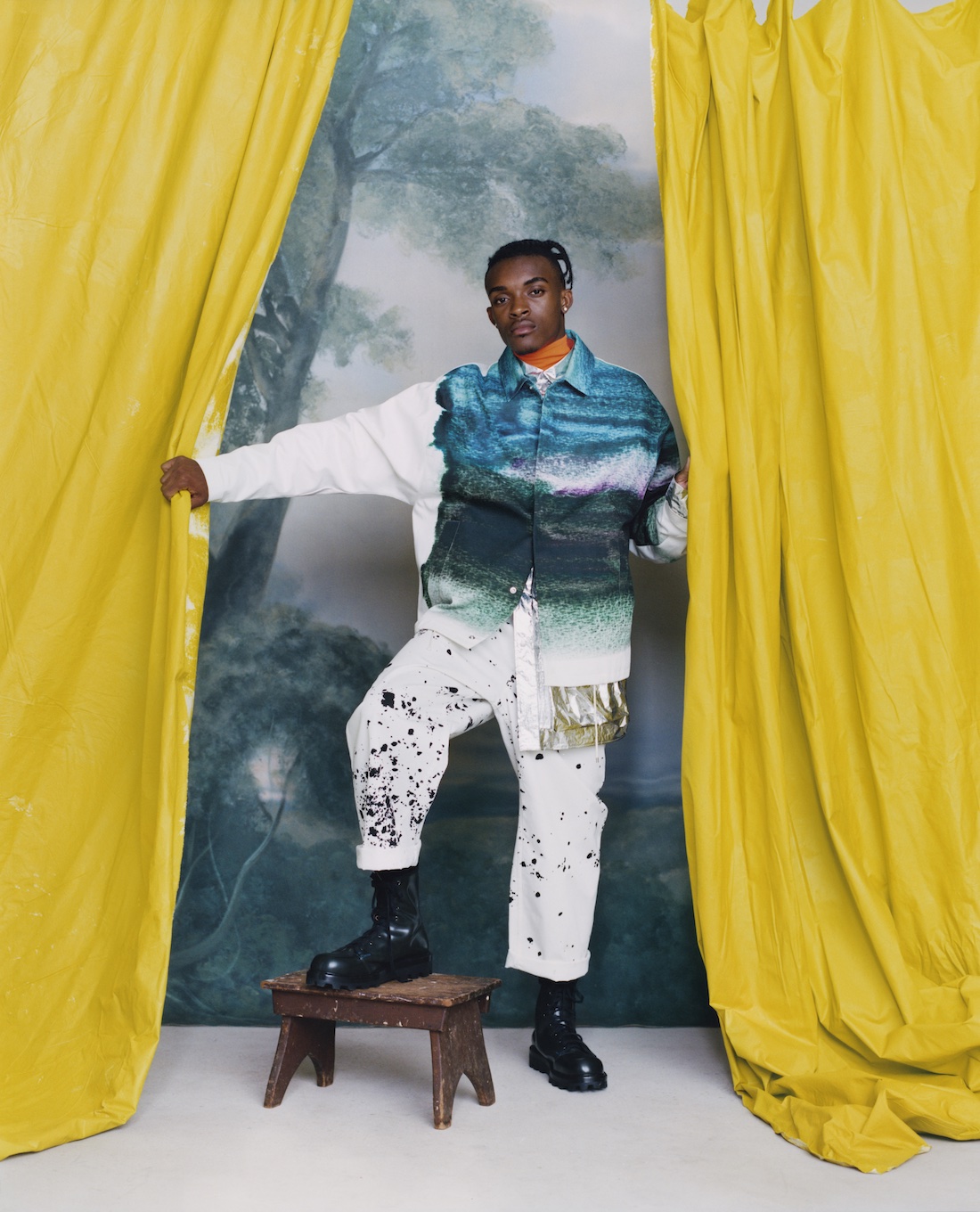 Tyler Mitchell, “Curtain Call,” 2018, courtesy of Tyler Mitchell.
Tyler Mitchell, “Curtain Call,” 2018, courtesy of Tyler Mitchell.
WW: Is there one work in the C/O Berlin show that encapsulates what you’re describing?
TM: The feature image of the show is strangely not an image I would say is that. It’s interesting making a show that looks at almost ten years of work, that brings together new ideas and old into one room. Somehow, one image becomes a gem and suddenly contains all the ideas you’ve been obsessed with over the years.
That image is Curtain Call. It’s a stage image made in the studio of a young man opening chartreuse curtains to reveal a scenic painted canvas backdrop. It layers in many ideas because it nods to African and studio photography, African American studio vernacular photography. It calls forth to mind the work of photographers like James Van Der Zee and Seydou Keïta. Behind it are also metaphors about the artifice of nature, the beauty of the stage portrait, and the presentation of Black life. There are all these ideas behind a very staged, prideful presentation-type of portrait.
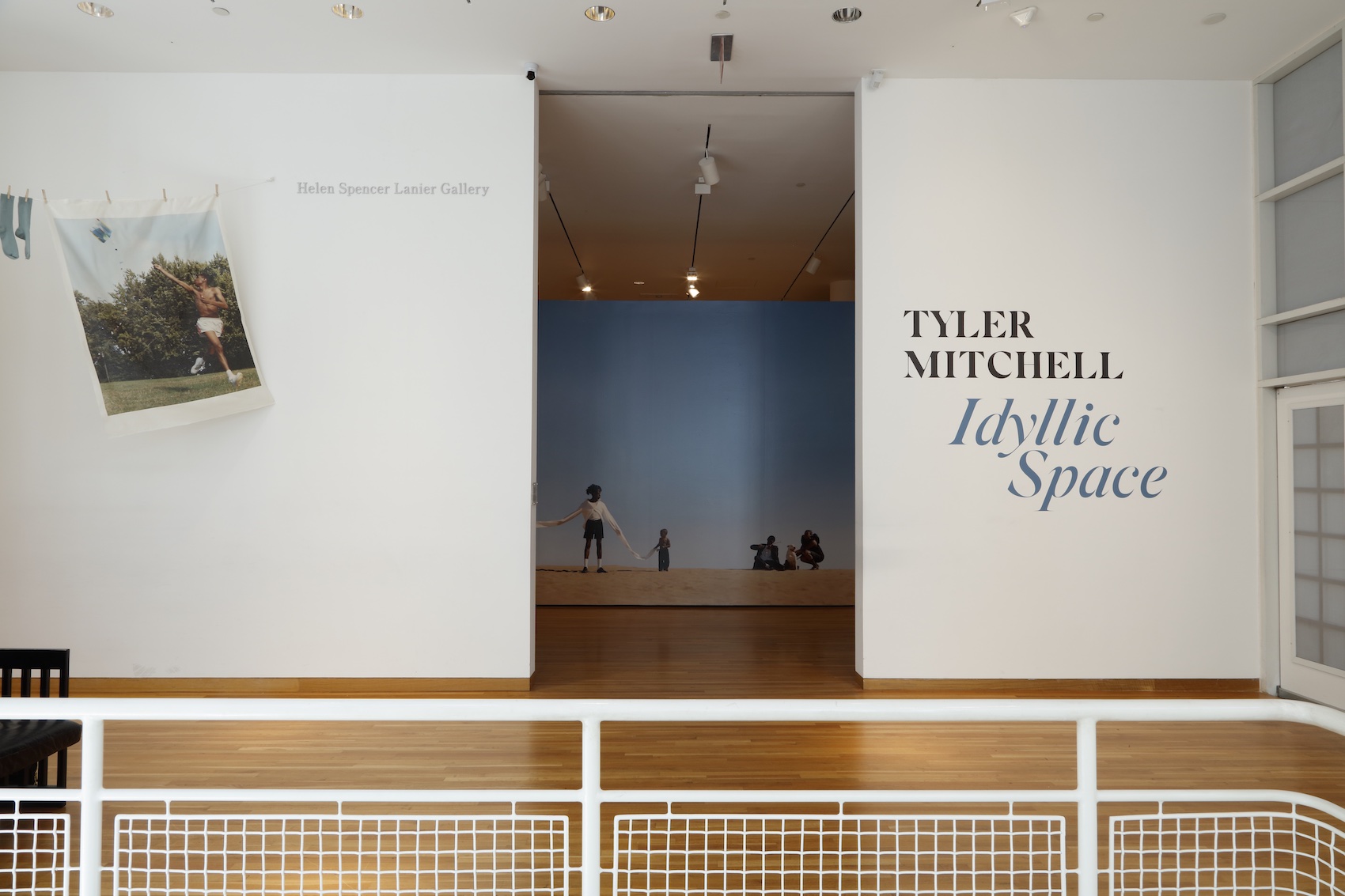 Installation view of “Idyllic Space” by Tyler Mitchell at the High Museum, courtesy of the museum.
Installation view of “Idyllic Space” by Tyler Mitchell at the High Museum, courtesy of the museum.
WW: “Idyllic Space” at the High Museum opened one month later, featuring over 30 photographs and a new photo sculptural artwork. Does it feel monumental to return to your hometown and present this? Was that the first large museum you visited while growing up in Georgia?
TM: Yes, it was. It is monumental and does feel special for the reasons you named. The show is a selection of works that two curators at the High Museum, Marie Kelley and Michael Rooks, and I curated together. We knew we wanted to make a presentation about my meditations on home—even if they were photographs that weren’t geographically made in Georgia. Some of them are, but there were others, like some commissioned by Louis Vuitton and personal images I made in the U.K. Throughout my global travels and even my commissions, as a photographer working between these spaces of art and fashion, I was always making images that conceptually meditated on what it meant to be from the South.
As I stage this show, I think about the idea that in the contemporary places a lot of us in the art world live in—like New York and L.A., big metropolises—people often, in America especially, think of the South as this backwater place, retrograde place, a conservative place. As something not up to speed with the contemporary, cutting-edge conversations happening where they think they live.
So this exhibition is also about claiming the importance of the city of Atlanta. Claiming the importance of all its elements, within my life and practice, which I feel fortunate has expanded to prominence in multiple cities. I like traveling to London and Paris and L.A. and telling people I’m doing a show in my home city of Atlanta—and being prideful. That gesture means a lot in recentering Atlanta and the American South as being at the visual root of a lot of what this country is about. The photographs you see are a depiction and a meditation on that, as well.
“This exhibition is also about claiming the importance of the city of Atlanta”
Tyler Mitchell
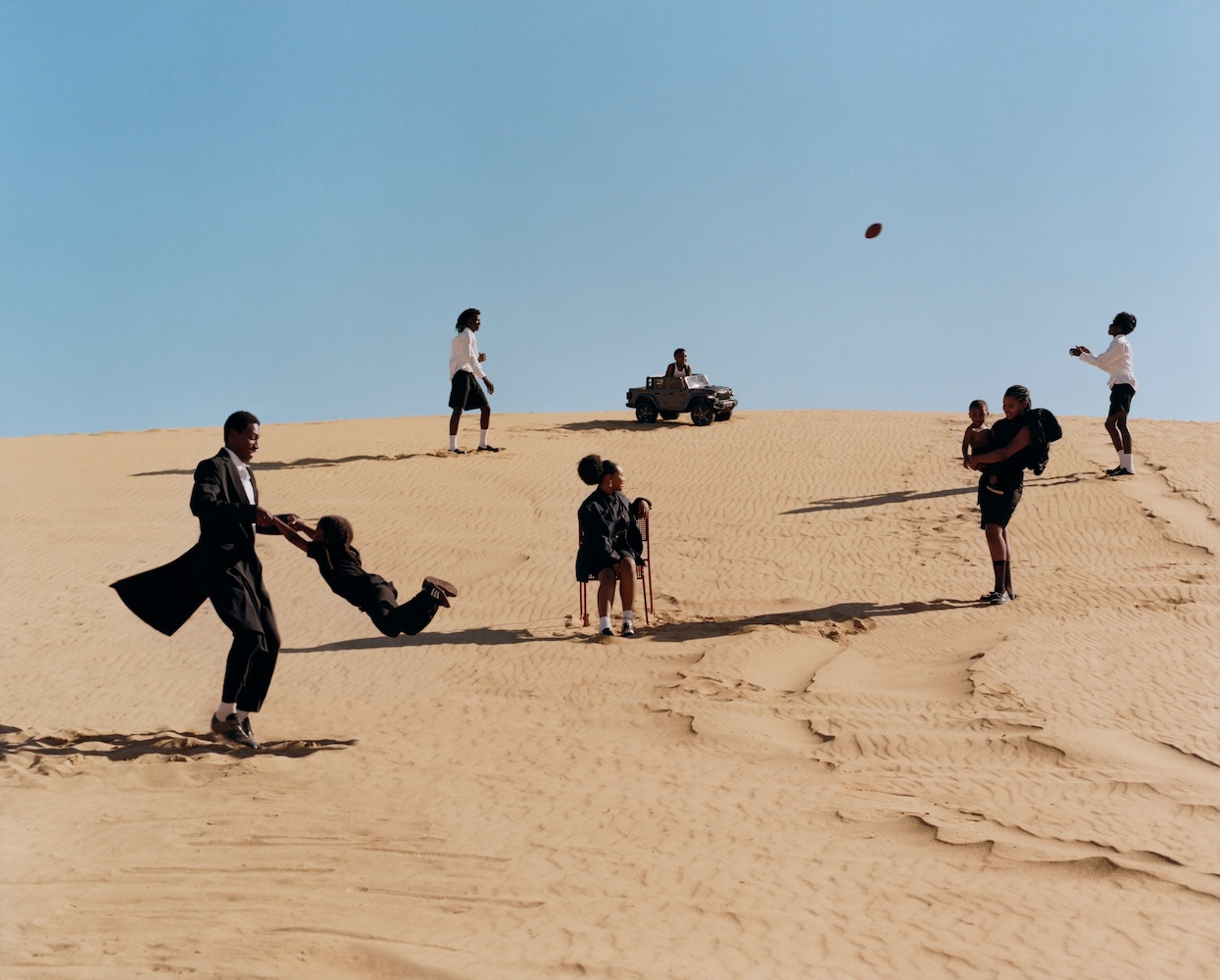 Tyler Mitchell, “Albany,” Georgia, 2021, courtesy of Tyler Mitchell.
Tyler Mitchell, “Albany,” Georgia, 2021, courtesy of Tyler Mitchell.
WW: Do you remember the first exhibition you saw at the High Museum?
TM: Yes, I believe I was seven or eight. It was an exhibition of the Gee’s Bend quilters—a group of mostly Black women quilt-makers in Alabama. They make beautiful quilts out of numerous fabrics, whether they’re typical American fabrics, like denim or gingham, or even African fabrics. There’s a weaving of history and narratives in their work. They come out to be these pieces that stand up to the Ellsworth Kellys—your Modernist color-blocking artists that have been canonized. For me, they place themselves within this lineage without directly addressing it.
As a kid, I didn’t know any of this conceptual or theoretical stuff, but walking in, I felt on a gut level that I was for the first time aware that I was looking at objects that had been made by Black people. Probably by Black women, but definitely by Black people.
I remember thinking, “Those feel aesthetically Black to me.” And knowing my parents, they felt close to home. They felt close to my parents’ generation or my parents’ parents’ generation. That filled me up with warmth, that I was able to walk into this place—somewhere I was taught was a grand, big place with important objects—and have objects feel like something that could have existed in my home growing up was great. That didn’t trigger something immediately, but the significance of all of that experience as a child sits against the backdrop of doing that exhibition today.
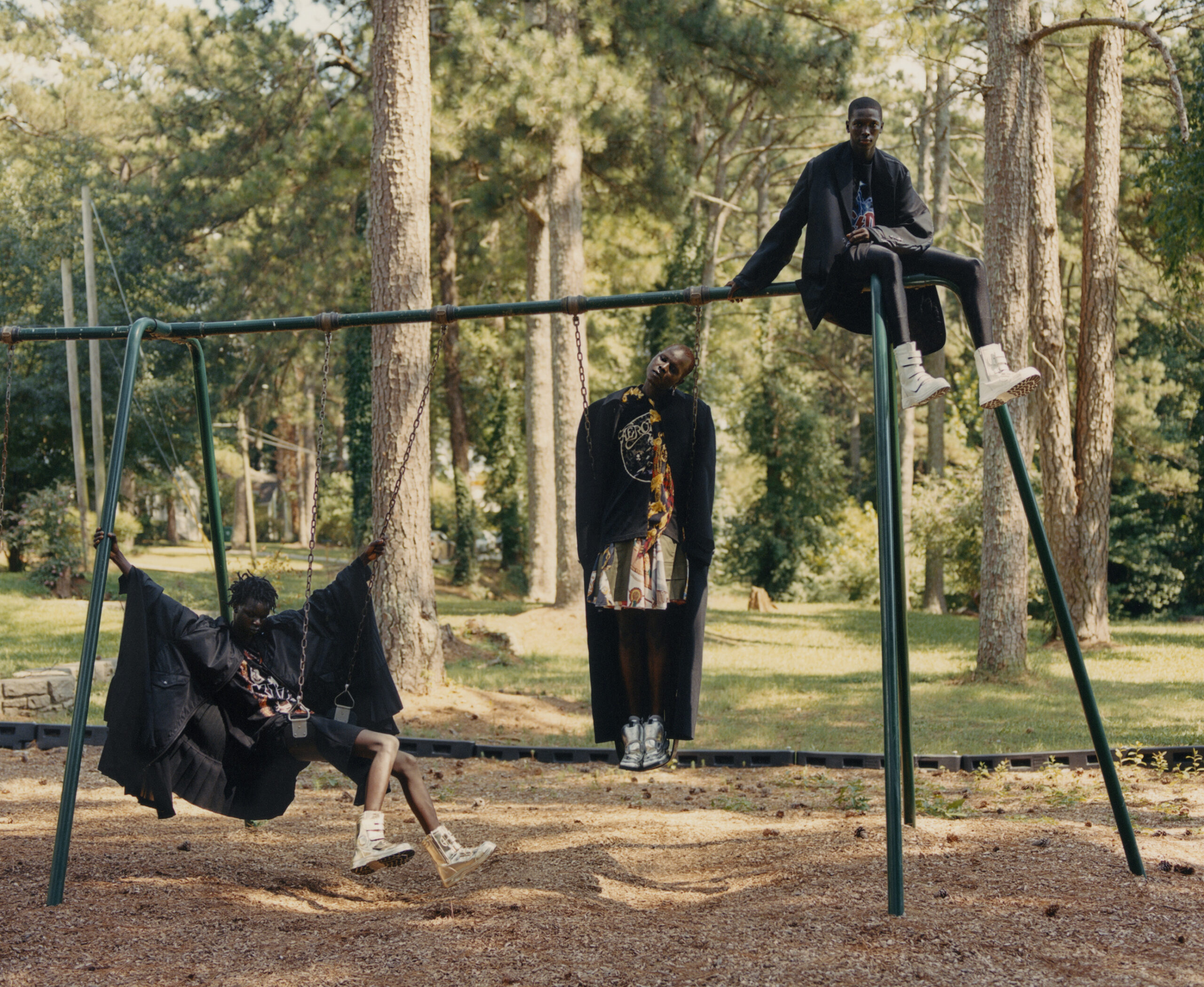 Tyler Mitchell, “Untitled (Brothers of Suburbia),” 2021, courtesy of Tyler Mitchell.
Tyler Mitchell, “Untitled (Brothers of Suburbia),” 2021, courtesy of Tyler Mitchell.
WW: The C/O Berlin show also features an exhibition-within-an-exhibition of works you curated from artists you admire and work alongside. The Gee’s Bend quilters are included in that, correct?
TM: Yes. As I staged this show at home, home came with me abroad. It’s meant to present a multifaceted intergenerational group of artists I’m inspired by, indebted to, or in dialogue with so that a German audience can more holistically understand the ideas in my images. The Gee’s Bend quilters are included in that. Home means a lot—for me to be showing at home and bringing formative experiences from home to Germany and abroad, as well.
WW: What other artists are included?
TM: Rashid Johnson, Hugh Hayden, Grace Wales Bonner, Garrett Bradley, Gordon Parks, Carrie Mae Weems, Dawoud Bey, Paul Strand, Mark Cohen… I really wanted to situate and map their beautiful works in and amongst my own as a way to point to all the things I’m looking at—whether it’s prop photo history, like with Paul Strand, or a proper contemporary photo giant like Carrie Mae Weems and Dawoud Bey. Or even non-photo practitioners, like Rashid Johnson and Hugh Hayden. This was about mapping and understanding the concept of metaphors going on in my work and celebrating those artists.
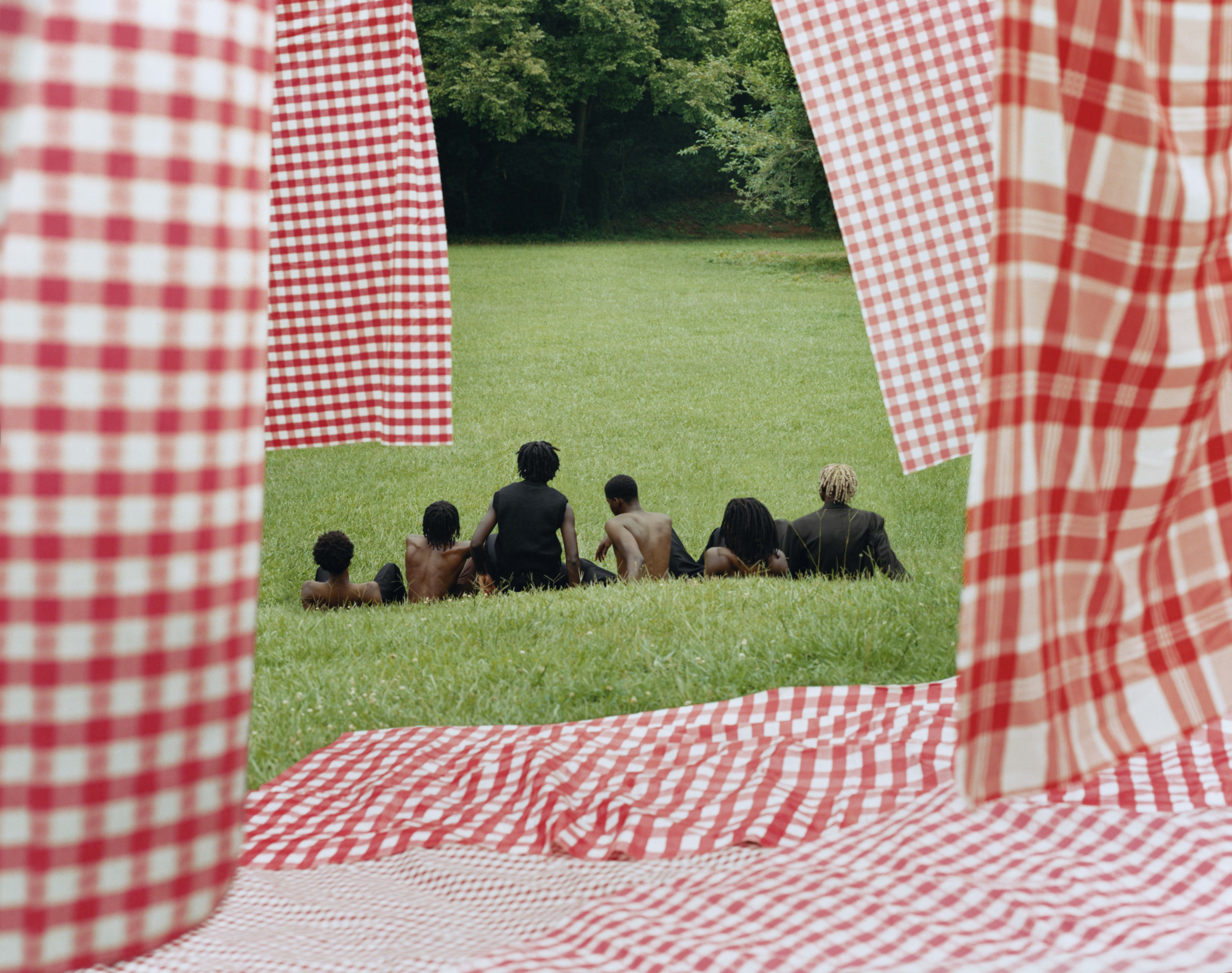 Tyler Mitchell, “Gingham Boys,” 2021, courtesy of Tyler Mitchell.
Tyler Mitchell, “Gingham Boys,” 2021, courtesy of Tyler Mitchell.
WW: You said that while looking at Gee’s Bend quilts you had a gut feeling about what they were trying to communicate without visually showing it—and you do that with your work, too. Is that underlying message something you think about?
TM: Increasingly, yes. It feels extremely important to make images that, even if they’re made in a fashion context or abroad, have something that feels aesthetically of my sensibility. My sensibility is only born out of the things I’ve grown to experience or be part of. When I’m making, and I’m thinking about not necessarily depicting a thing, and that photography can exist outside of its didactics—outside of the biographical facts, like this image was made in New York in the 1970s, therefore it’s about New York in the 1970s. My work tries to avoid some of those biographical facts and instead favor a certain timelessness to allow the viewer to fall into the work wherever they may stand with it. It takes on a more abstract or metaphorical quality in that way.
I’ve also become obsessed with these ideas of traces of figures in a frame. Making an image that feels of a lived Black American experience, but that doesn’t always have a figure in it. It might have traces of a figure in it. That has led the work to head into more of a loosely abstract direction. All these things fascinate me—and probably started with some of those gut childhood experiences of seeing the Gee’s Bend quilts, folk art, Southern art, not understanding it but internalizing it.
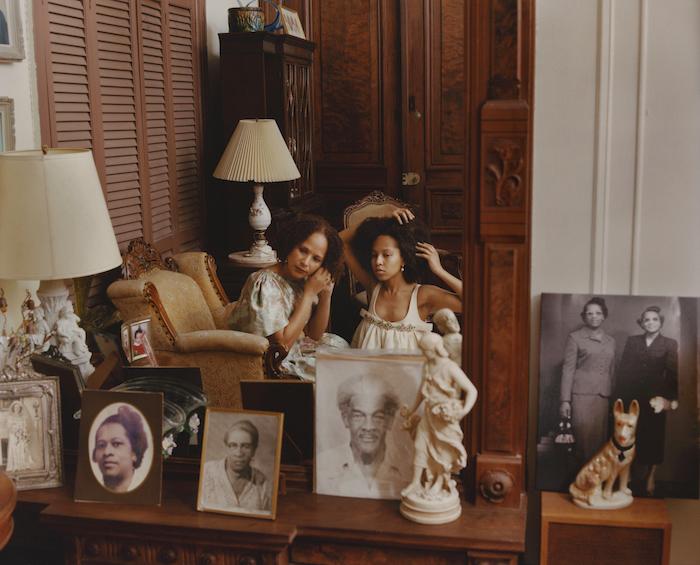 Tyler Mitchell, “Ancestors,” 2021, courtesy of Tyler Mitchell.
Tyler Mitchell, “Ancestors,” 2021, courtesy of Tyler Mitchell.
WW: We’ve seen your work printed on different materials, including fabric hung on a long laundry line. How are you thinking of photography as an art object?
TM: The meaning of photography as a timeless art form, or photography as an object, has become a central focus for me. We live with images on our phones, on our computers, and on social media that are here today and gone tomorrow. I’m constantly asking myself what it means to be a photo practitioner today and how to engage with making images that hopefully exist beyond that timeline, the “here today, gone tomorrow.” Every artist wants their work to be revisited, engaged with, thought about, and held in esteem for long periods of time. To do that, there are many strategies. But I get really excited about encouraging the physical experiences with photographs. That’s where gestures like the fabric works emerge from.
It’s both a conceptual idea and a formal idea of making wonderful visual works. The idea encourages a viewer to take a trip to a space and have a physical experience with the work. That’s much more important or powerful than seeing something on a screen. There are great uses for seeing images on screen, and I love it, but I did a laundry line installation to bring some of the ideas in my work to a new place. It allows the work to be experienced in a new way. Even the way that wind wafts past some of the pieces, and that that subjective viewing of the work can’t be redone, that it changes and isn’t fixed. That excites me.
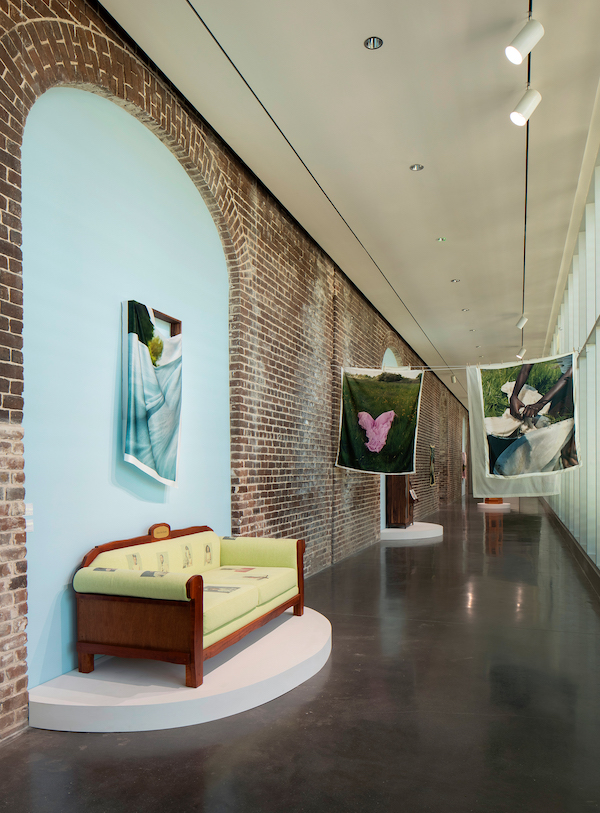 Installation view of Tyler Mitchell’s exhibition “Domestic Imaginaries” at SCAD Museum of Art in the Pamela Elaine Poetter Gallery, courtesy of SCAD.
Installation view of Tyler Mitchell’s exhibition “Domestic Imaginaries” at SCAD Museum of Art in the Pamela Elaine Poetter Gallery, courtesy of SCAD.
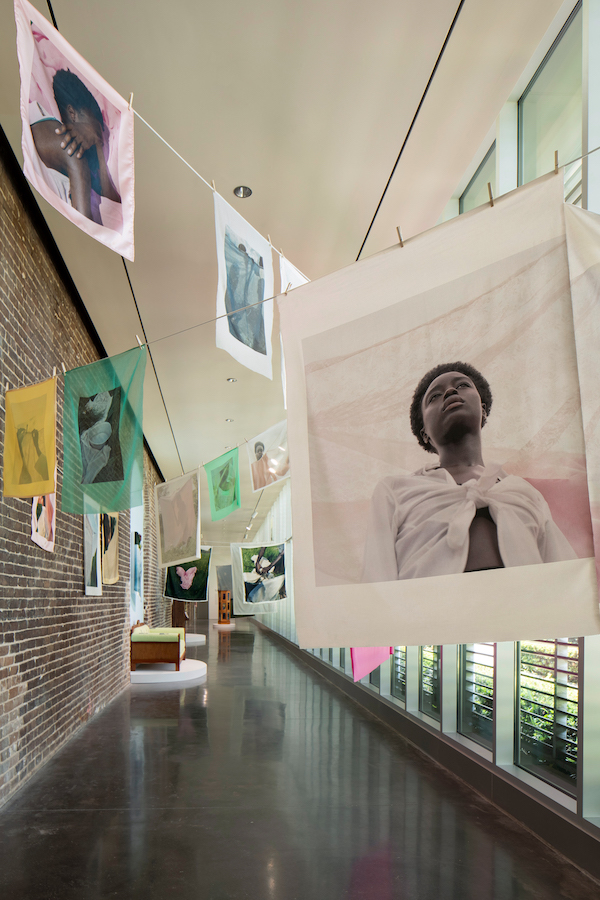 Installation view of Tyler Mitchell’s exhibition “Domestic Imaginaries” at SCAD Museum of Art in the Pamela Elaine Poetter Gallery, courtesy of SCAD.
Installation view of Tyler Mitchell’s exhibition “Domestic Imaginaries” at SCAD Museum of Art in the Pamela Elaine Poetter Gallery, courtesy of SCAD.
WW: Last year, you also presented a show at SCAD’s campus in Savannah, Georgia, showing some of these fabric works, as well as photographs on other mediums. How did that elaborate on the message of photographs as art?
TM: That was entirely materially based. All prints were done on a variety of fabrics. There were also prints done on glass and aluminum, and then embedded into these furniture-like sculptures. In the High Museum show, there will be one of those. I’m just evolving the form slowly. I’m first starting with the images, because I’m a photographer and not interested in passing myself off as a sculptor. But with the image at the center of the whole story, I am getting excited about how to create engaging experiences in a physical form with them.
I’d be remiss not to mention Deana Lawson. I had a formative studio visit with her two years ago, but our conversation still means a lot. She encouraged me to think more materially about photographs as objects. She sent me a great essay about materiality and photography that opened up how I can think about what my work does. She is so brilliant in her own way in doing that with mirror frames, her holograms, her understanding of photographs as capturing light, her obsession with the cosmic and star constellations.
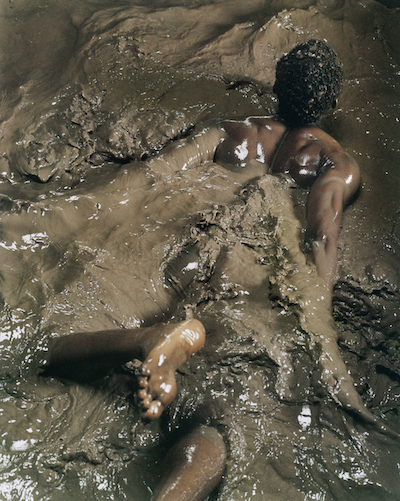 Tyler Mitchell, “Chrysalis Flotation,” courtesy of Tyler Mitchell.
Tyler Mitchell, “Chrysalis Flotation,” courtesy of Tyler Mitchell.
WW: You’ve shot both familiar and influential people from an array of industries. How does it feel to connect with your subjects in this way?
TM: I get excited by growing close to people through photography, and by witnessing play in the work that I’m making. I get excited by creating moments with someone as well known as Beyoncé—or my friend Ayo Edebiri, or most recent portrait, Erykah Badu—to someone I street-cast or one of my friends on a day-to-day level. Creating and routing sites of play, expression, and enjoyment in those genuine moments, those intimacies and connections, bring me joy. Finding those with that person feels more like exploration, like art, than it does math or science.
I think about Richard Avedon and Gordon Parks, who were genuine Renaissance artists in a classic way. They had multiple interests—in celebrity culture, the inner lives of musicians and actors of the era—as well as their own work. There wasn’t much division there. For me, it’s the same.
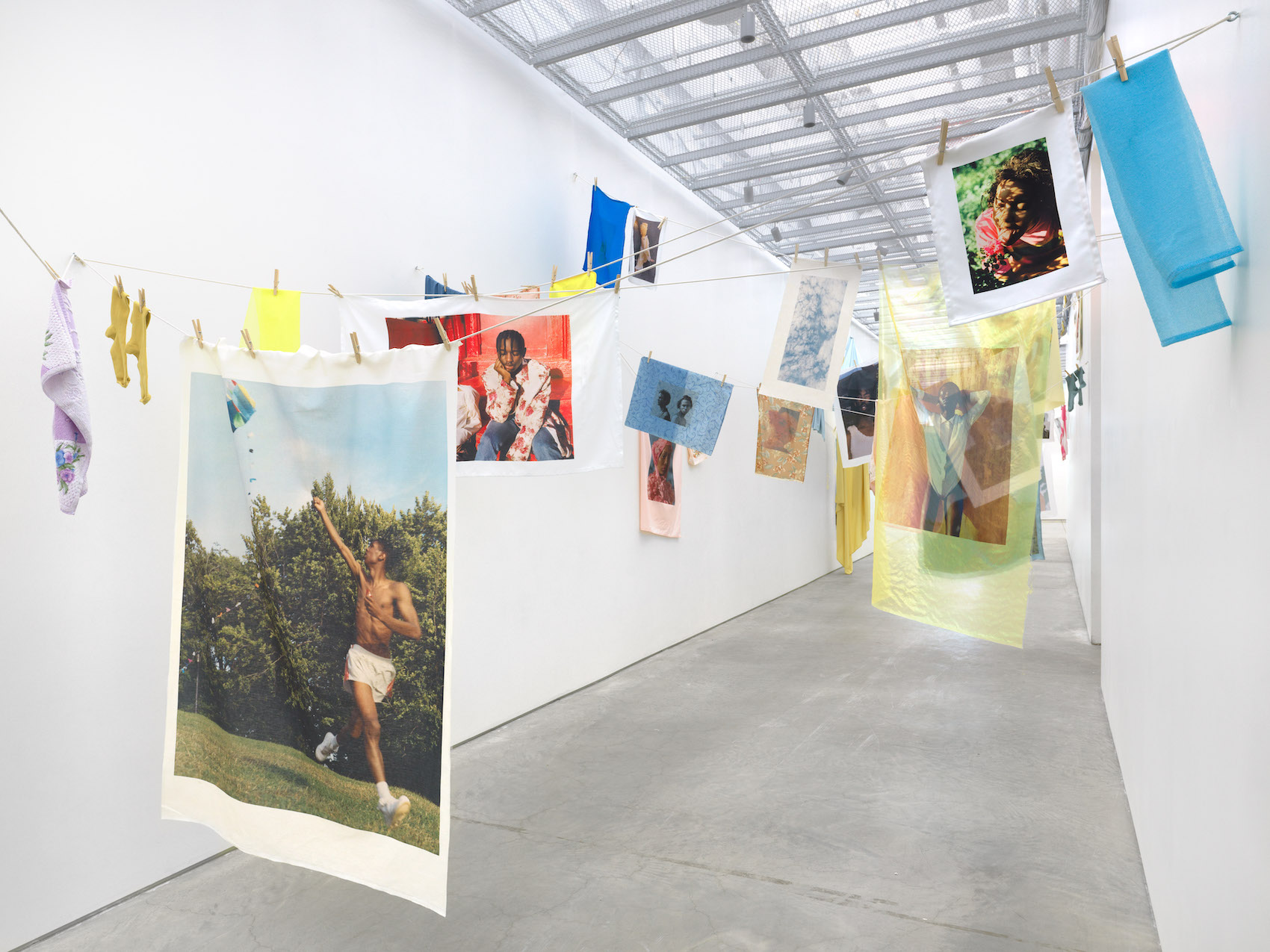 Installation view of Tyler Mitchell’s exhibition “I Can Make You Feel Good” at the International Center of Photography, courtesy of the museum.
Installation view of Tyler Mitchell’s exhibition “I Can Make You Feel Good” at the International Center of Photography, courtesy of the museum.
WW: On Instagram, we saw a video of you going into the Criterion Collection’s archive and highlighting some of your favorite films, including The Watermelon Woman, L’argent, Late Ozu Box Set, and Claudine, among others. What kinds of films inspire you, as someone that went to school for film?
TM: Films that do a little bit of that re-looking. There’s a film called South by Chantal Ackerman. It’s a movie about a pretty horrifying subject matter, but what’s interesting about it as a movie is that it’s made by a French woman, Chantal Akerman, who we know, who made a trip to Texas to create a documentary about a Black man who was dragged down a three-mile stretch of road in Texas at the end of a chain on a truck by these white men who basically lynched him. It happened in the eighties. It’s horrific and hard to talk about, but she made the film in such a way that you didn’t know what she was exactly talking about until about 40 minutes into the movie. All you got were these bucolic, charming, almost enchanting shots of the road. A bunch of shots of the long stretch of road. The events of what happened on that road unfold throughout the film in interviews. What I’m thinking about here is uncovering histories. Doing that in artful ways through film, and re-looking at things. On the other side, I’m also fascinated by this idea of interiority and quiet.
There’s a book by Kevin Quashie called The Sovereignty of Quiet, and it talks about having a rich inner life as a counterpart to outward forms of resistance. How we understand Black life as being about resistance and how that’s important, but the idea of how quiet is also important. I also just watched Challengers, which was great. What I’m saying is that we’re all taking in a range of inspirations at any moment. That’s the constellation of contemporary living. It can go from Challengers to The Sovereignty of Quiet to South.
WW: In your photographs, you’ve captured this interiority—inner peace, joy, youth. Has that helped you embrace your own interiority? Has it helped you find yourself?
TM: Absolutely. That’s part of it. And finding myself through making the work. It’s understanding what I like by making that work, and that gives me joy. It’s a personal exploration because it’s vulnerable to make pictures and show them. To make those works, it says, “This is what I’m about. This is my vision of what’s important. Of what personal agency and empowerment and self-determination looks like.” Then, it’s rooted in all these things that have to do with transcendence, the sublime, and of course, at the center of that is repose, leisure, and play. Those things are huge explorations for me in my own life.
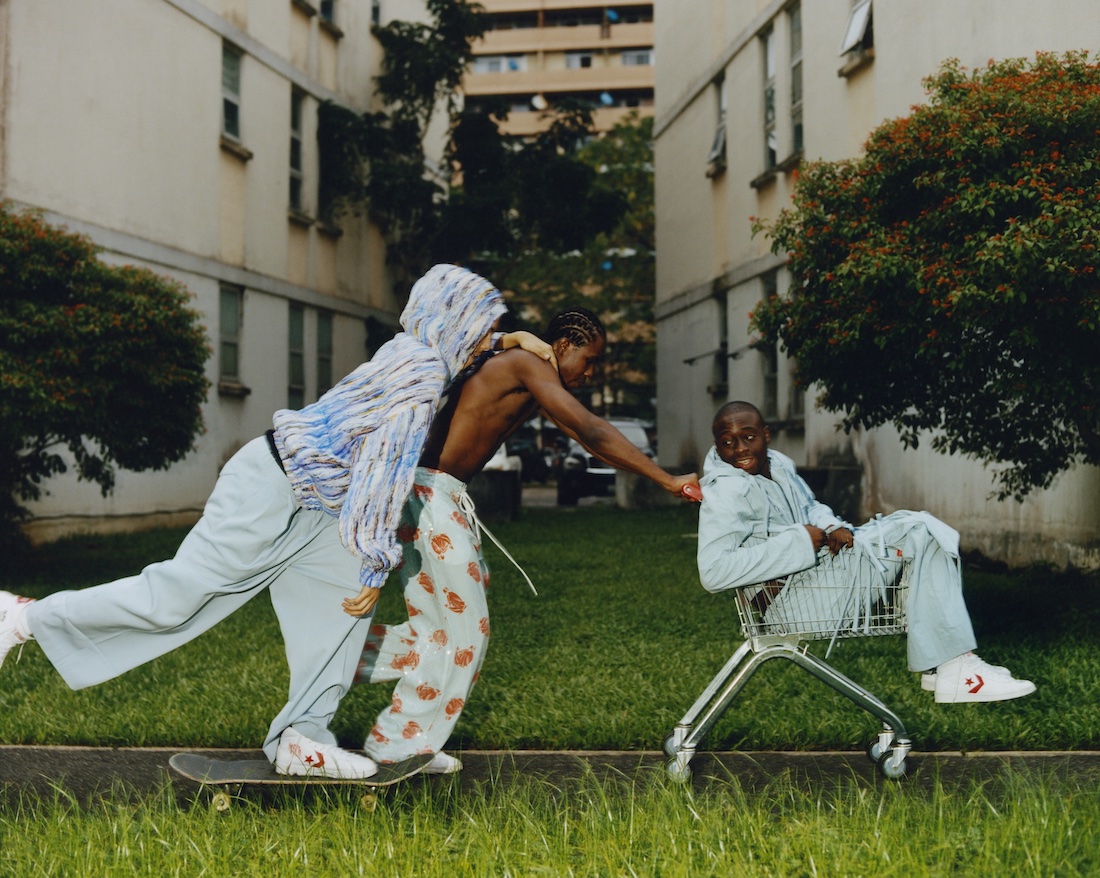
WW: Aside from your two shows opening, what are you looking forward to this fall? What’s the vibe?
TM: The vibe is new. New places, new experiences, tastes, travel, friends. It will feel like a rebirth to mount these shows. After that, I will be ready to see something new. I’m going to travel through Germany with my girlfriend and reconnect with old friends in different parts of the world. I’m going to focus on myself, and that whole thing we call living. Then, dialing back into slowly starting to make new things. I’m also coming to grips with growing up, in a way, and that feels like an exciting thing. It’s facing one’s responsibilities. As that realization sits in deeper and deeper, it’s like, “You have to make your own summer,” so to speak. I’m curious to see what the people in the arts space of this generation will make of this summer. What will change after. It’s almost like school in that way. There will be a lot of change—and I’m excited to see how I’ll change and how others will, too.
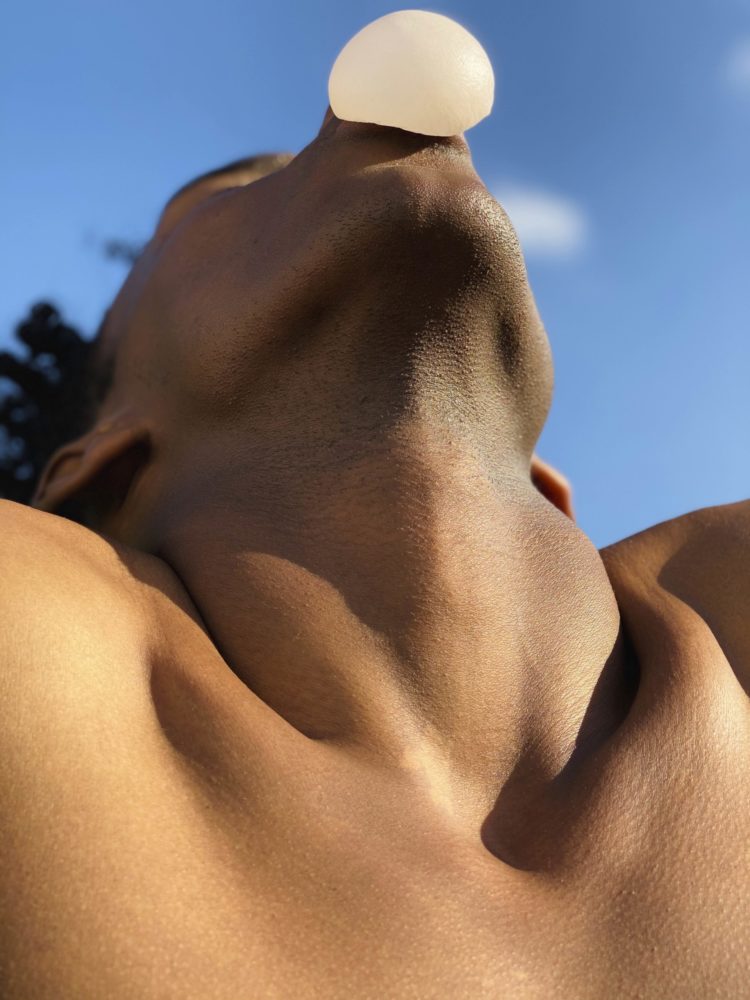 Tyler Mitchell, “Untitled (Bubblegum),” 2019, courtesy of Tyler Mitchell.
Tyler Mitchell, “Untitled (Bubblegum),” 2019, courtesy of Tyler Mitchell.
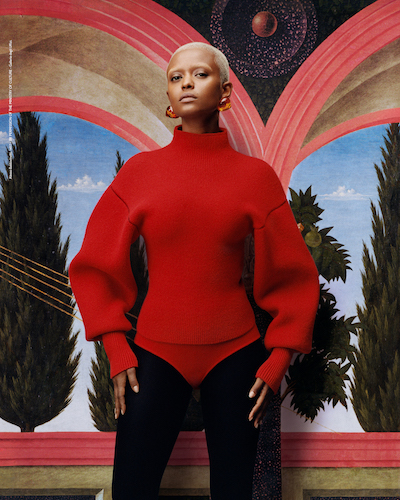 Photo by Tyler Mitchell, courtesy of Ferragamo and Uffizi Gallery, Florence.
Photo by Tyler Mitchell, courtesy of Ferragamo and Uffizi Gallery, Florence.
WW: What do you hope the impact of your work is and will be?
TM: I hope it’s abundantly clear in the work, and I hope it evolves, that the complicated act of being human and evolving is possible and real. That is more of a gesture of the overall arc of my work. The impact I also want to leave is sustained engagement with Black artist production. That it will always be global, it will always be important. Not just with my practice, but also with my peers.
This is also about the people who I stand with, and who have come before. I hope to leave that impact. Those things come first, before my own desires. Those things are more important.
And for myself, I just hope that people get that my work continues to be about prompting and putting forth this idea of the personally transcendent. Whether that’s through this gesture of play, of leisure, of pure and inner quiet and selfhood, agency, self-determination, empowerment. All those themes that run through the people that I depict. Personhood. Personal paradise. I hope that that continues to reach more and more people. I hope that stays at the forefront of my practice. I hope that that’s my impact.
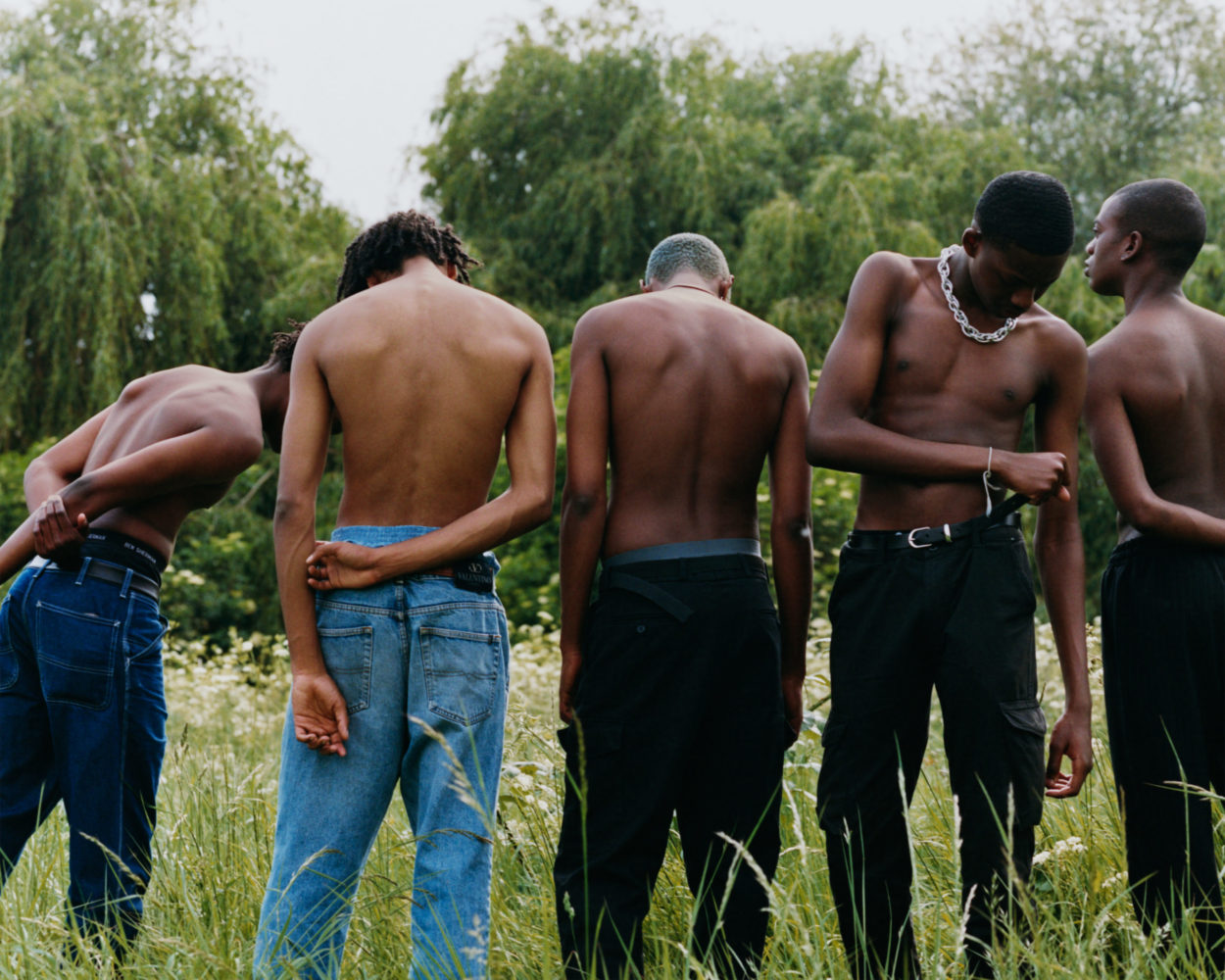 Tyler Mitchell, “Boys of Walthamstow,” 2018, courtesy of Tyler Mitchell.
Tyler Mitchell, “Boys of Walthamstow,” 2018, courtesy of Tyler Mitchell.






